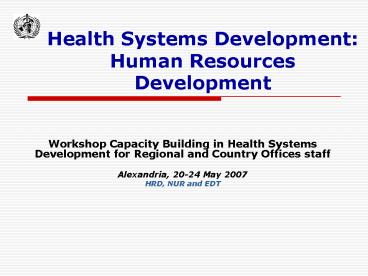Health Systems Development: Human Resources Development - PowerPoint PPT Presentation
1 / 27
Title:
Health Systems Development: Human Resources Development
Description:
Objective: specify numbers, skills & utilization pattern of HR ... Deterring negative work environment. Lack of career development. Low incentives & motivation ... – PowerPoint PPT presentation
Number of Views:34
Avg rating:3.0/5.0
Title: Health Systems Development: Human Resources Development
1
Health Systems DevelopmentHuman Resources
Development
- Workshop Capacity Building in Health Systems
Development for Regional and Country Offices
staff - Alexandria, 20-24 May 2007
- HRD, NUR and EDT
2
Outline
- Health systems and HRH
- HR Development stages
- Situation and shortcomings
- HRD Interventions
- Success stories
- Conclusions
3
Human Resources for HealthWho are they?
Volunteer Health Carer
Non-Health Professionals
Health Professionals
Global 40M Health Professionals
20M Support Millions of Carers
Families
Individuals
HR Cross cutting function
Formal Health Systems
Formal Health Systems Related Systems
Communities
4
HRH and Health Outcomes
Source (117) Anand Baernighausen- 2004 (JLI)
5
HRD usually Numbers-Game
Efficiency HRH and Health System
NOT ENOUGH
6
HRH and Health expenditure (size) and burden of
disease
7
EfficiencyHuman Resources Development
8
SCOPE OF HRD PROCESS (1-3 ). Planning
- Objective specify numbers, skills utilization
pattern of HR needed to improve health up to a
proposed level - Activities
- evidence-based strategic operational planning,
- programming, Coordination,
- Monitoring/evaluating implementation,
- HR information systems and research.
- Targets x health teams of
y competences in operation by t time.
9
SCOPE OF HRD PROCESS (2-3). Production
(pre-service training)
- Objective Produce x
professionals of y competences - Activities
- Enrolment admission procedures,
- Curriculum,
- Learning assessment methods,
- Accreditation improvement
- Targets X trained HRH of y categories
competences by t time.
10
SCOPE OF HRD PROCESS (3-3). Utilization
- Objective Optimum HRH utilization
productivity. - Activities
- Recruitment. selection procedures deployment,
- Staffing patterns, job description,
- Standards, regulations, certification,
- CPD career schemes,
- Motivation retention
- Targets x units of service of q quality
delivered to p population/Coverage
11
HRD Shortcomings gaps
- Weak HR information and research
- Weak planning, weak HRD units
- Non-responsive pre-service education
- Shortage imbalanced demand/supply
- Mal-distribution
- Inappropriate skill mix (HRH categories)
- Migration expatriates
- Deterring negative work environment
- Lack of career development
- Low incentives motivation
12
(No Transcript)
13
Regional Mal-distribution EMR
(population per one professional)
Phys. Pharm.
Dent. Nur
Minimum 8300 1000000 500 000
5 500
Maximum 342 1 280
960 225
EMR Average 1 030 3 330 7
140 625
WHO/EMR RDs Annual Report, year 2004
14
Ratio of Nurse/Physician in OECD (1) EMR (2)
15
Increase in No of Med schs Other categories?
College for Million World average 3 EMR
average 2.1
16
Health Professions Education Challenges
- Skills matching evolving needs
- Lifelong learners changes to 2050
- Quality Improvement Accreditation.
- Meeting evolving scenarios
- Epidemiological transition
- Demographic transition (ageing)
- High population expectations
- Changing practice pattern (solo/group)
- Privatisation and market economy
- Rapid advances in biomedical technology
17
Reforming HPE curricula
Inappropriate HR to practice
Inappropriate HR to needs
Appropriate HR to HS
18
USE OF WORKING TIME/SKILL MIX UK MMC
19
Regional HRD projects
- HR mapping HRH information system (14
countries) - Scaling up nursing/midwives/allied leadership,
training - Regional projects to strengthen PH FM education
/ training - Supporting integrating service /edu
- Regional HPE Accreditation Board, national
systems, reform. - Regional/national HRH observatory
- Support HRD National Units
- HR essential sustainability element in Vertical
Programmes.
20
FOUR METHODS OF ESTIMATING HRH REQUIREMENTS
HEALTH NEEDS Estimated health services Needed
to attain and Promote health
Services converted into HRH by use of empirical
or normative staffing productivity standards
Health servicesneeded (numbers,skills, quality)
Targeted population Character- istics
HRH Nos, skills,qualification,distribution,
etc.
SERVICES TARGETS Health service targets,
priorities, health wants, technical,
administrative financial feasibility.
Health services to be provided (numbers,
kind,quality)
HEALTH DEMANDS Estimated effective demand
(actual use) for services as a function of
wants, price, accessibility.
Health services to be demanded (numbers,
kind,and quality)
Services convertedinto HRH by use ofempirical
staffing productivity standards
HRH / POPULATION RATIOS Calculated ratios
required by means of desired/empirical/
normative ratios based on diverse criteria TO
full-time equivalent
21
- A Success Story Brazil PHC reform 1998-2005
- Changes to funding create a national per capita
spending for all municipalities - Special funding to build family health teams for
each municipality - HRH utilization create conditions to attract HRH
to the new strategy and gain sustainability - Defining the essentials composition of teams
their core competencies in urban rural areas
focus on PHC - Each team, assigned to a catchment geographical
area responsible for 800 to 1000 families
22
Per capita distribution of the Federal Budget for
PHC (pop/yr) BRASIL 1998 to 2005
1998
2005
- 20 21 to 40 41 to 60 61 to 80 Over 80
SOURCE DATASUS
23
Target and actual number of health family teams
Brazil, 1994 2005
FONTE SIAB - Sistema de Informação da Atenção
Básica
24
Yes, creating relevant Skill Mix can change
coverage
Actual of population covered by the health
family teams Brazil, 1998 2005
0
0 a 25
25 a 50
50 a 75
75 a 100
FONTE SIAB - Sistema de Informação da Atenção
Básica
25
Conclusions
- Effective health coverage achieved when HRD
planned as an integral part of national health
planning. - Competent appropriate HRH teams are essential
for efficient health systems. - HRD is a difficult function but needs continuous
support development. - Any vertical health programme needs to address
HRD stages to secure sustainability despite huge
funding.
26
Thank you
27
Skill Mix in 14 EMR COUNTRIES































